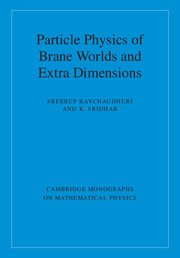Book contents
- Frontmatter
- Dedication
- Contents
- Preface
- 1 Dimensional dreams
- 2 The Standard Model and beyond
- 3 The birth of compact dimensions
- 4 String theory: a review
- 5 Effective theories
- 6 Large extra dimensions
- 7 Visible towers of invisible gravitons
- 8 Making black holes
- 9 Universal extra dimensions
- 10 Warped compactifications
- 11 Graviton resonances
- 12 Stability of warped worlds
- 13 Exploring the bulk
- 14 Epilogue
- Appendix A General Relativity in a nutshell
- Appendix B Testing the inverse-square law
- References
- Index
1 - Dimensional dreams
Published online by Cambridge University Press: 05 July 2016
- Frontmatter
- Dedication
- Contents
- Preface
- 1 Dimensional dreams
- 2 The Standard Model and beyond
- 3 The birth of compact dimensions
- 4 String theory: a review
- 5 Effective theories
- 6 Large extra dimensions
- 7 Visible towers of invisible gravitons
- 8 Making black holes
- 9 Universal extra dimensions
- 10 Warped compactifications
- 11 Graviton resonances
- 12 Stability of warped worlds
- 13 Exploring the bulk
- 14 Epilogue
- Appendix A General Relativity in a nutshell
- Appendix B Testing the inverse-square law
- References
- Index
Summary
Space: a historical view
Of all the aspects of the physical world, the mysteries regarding the nature of space and time are the most recondite. Questions related to the nature of space and time have engaged philosophers, mathematicians and physicists alike across histories and cultures. It appears that even in ancient cultures some thinkers concerned themselves with these questions but it was probably with the Greeks that an attempt at a systematic, physical understanding of space and time is discerned. This is not surprising given that the Greek interest in both geometry and mechanics was motivated by physical rather than metaphysical considerations. The famous antinomies of Zeno tell us that even pre-Socratic philosophers had devoted much thought to the understanding of space, time and motion. But somewhere in the period between Zeno and Aristotle, earlier meditations on these issues crystallised and were put down more concretely.
Between the Greek atomists and Aristotle, then, we have been provided two enduring conceptions of space which are broad enough to accomodate the whole gamut of ideas about space that have emerged over the centuries. For Aristotle, space did not have an existence independent of the material world but rather was a relational property of material bodies. Independent of matter, space had no existence: there was no conception of a vacuum. Any statement about space that is made is really a statement about a relation between different material entities. In contrast to Aristotle, and in fact preceding him, there existed another conception of space due to the atomists, prominent among whom were Leucippus and Democritus. The atoms, which were unchanging and eternal, gave rise to the variety and the change perceived in the phenomenal world by coming together in different ways as they moved about in the void. The void or empty space had an existence independent of the atoms that moved in them and was as fundamental as the atoms. These two views, relationalism (of Aristotle) and substantivalism (of the atomists), have been paradigmatic for theories of space that have been developed for over two millenia. While for the substantivalists, geometry has a significance of its own, for the relationalists it is something that can only be inferred from the properties of material bodies.
- Type
- Chapter
- Information
- Publisher: Cambridge University PressPrint publication year: 2016



